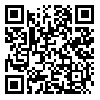Volume 18, Issue 5 (2016)
JAST 2016, 18(5): 1233-1246 |
Back to browse issues page
Download citation:
BibTeX | RIS | EndNote | Medlars | ProCite | Reference Manager | RefWorks
Send citation to:



BibTeX | RIS | EndNote | Medlars | ProCite | Reference Manager | RefWorks
Send citation to:
Ladjevardi Z S, Yarmand M, Emam-Djomeh Z, Niasari-Naslaji A. Physicochemical Properties and Viability of Probiotic Bacteria of Functional Synbiotic Camel Yogurt Affected by Oat β-Glucan during Storage. JAST 2016; 18 (5) :1233-1246
URL: http://jast.modares.ac.ir/article-23-1111-en.html
URL: http://jast.modares.ac.ir/article-23-1111-en.html
1- Department of Food Science & Engineering, Faculty of Agricultural Engineering and Technology, University of Tehran, Karaj, Islamic Republic of Iran.
2- Department of Food Science and Engineering, Faculty of Agricultural Engineering and Technology, University of Tehran, Karaj, Islamic Republic of Iran.
3- Department of Clinical Sciences, Faculty of Veterinary Medicine, University of Tehran, Tehran, Islamic Republic of Iran.
2- Department of Food Science and Engineering, Faculty of Agricultural Engineering and Technology, University of Tehran, Karaj, Islamic Republic of Iran.
3- Department of Clinical Sciences, Faculty of Veterinary Medicine, University of Tehran, Tehran, Islamic Republic of Iran.
Abstract: (6643 Views)
The unique properties of camel milk, qualify this product to be used as a nutraceutical. In this study, functional synbiotic yogurt made from camel milk has been investigated in three levels of fat (0, 2.5 and 5% (w/v)). Probiotic bacteria (Streptococcus thermophilus, Lactobacilus delbrueckii and ssp. bulgaricus.) and β-glucan (prebiotic agent) were added in three levels of concentration (0.5, 1 and 1.5 % (v/v)) and (0, 1 and 2% (w/v)), respectively. The physicochemical properties of the product and viability of probiotic bacteria were measured on the 0, 7th and 14th days. Beta-glucan, fat and storage time had significantly (P< 0.05) increasing effects on viscosity, Water-Holding Capacity (WHC) and the viability of probiotic bacteria. These parameters caused decrease in syneresis and pH of yogurt. It was concluded that the addition of oat β-glucan to camel milk to make functional synbiotic yogurt could result in a product of acceptable physicochemical properties.
Article Type: Research Paper |
Subject:
Food Science and Technology
Received: 2015/03/15 | Accepted: 2015/12/15 | Published: 2016/09/1
Received: 2015/03/15 | Accepted: 2015/12/15 | Published: 2016/09/1
| Rights and permissions | |
 |
This work is licensed under a Creative Commons Attribution-NonCommercial 4.0 International License. |







